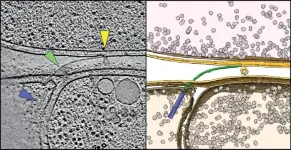(Press-News.org) A major new study reveals that carbon dioxide (CO2) emissions from forest fires have surged by 60% globally since 2001, and almost tripled in some of the most climate-sensitive northern boreal forests.
The study, led by the University of East Anglia (UEA) and published today in Science, grouped areas of the world into ‘pyromes’ - regions where forest fire patterns are affected by similar environmental, human, and climatic controls - revealing the key factors driving recent increases in forest fire activity.
It is one of the first studies to look globally at the differences between forest and non-forest fires, and shows that in one of the largest pyromes, which spans boreal forests in Eurasia and North America, emissions from fires nearly tripled between 2001 and 2023.
Significant increases were seen more broadly across the extratropical forests and amounted to an additional half a billion tonnes of CO2 per year, with the epicentre of emissions shifting away from tropical forests and towards the extratropics.
Increased emissions were linked to a rise in fire-favourable weather, such as the hot-dry conditions seen during heatwaves and droughts, as well as increased rates of forest growth creating more vegetation fuels. Both trends are aided by rapid warming in the high northern latitudes, which is happening twice as fast as the global average.
The study reveals a worrying increase in not only the extent of forest wildfires over the last two decades, but also their severity. The carbon combustion rate, a measure of fire severity based on how much carbon is emitted per unit of area burned, increased by almost 50% across forests globally between 2001 and 2023.
The work involved an international team of scientists - from the UK, the Netherlands, US, Brazil, and Spain - who warn that further expansion of forest fires can only be averted if the primary causes of climate change, such as fossil fuel emissions, are tackled.
Lead author Dr Matthew Jones, of the Tyndall Centre for Climate Change Research at UEA, said: “Increases in both the extent and severity of forest fires have led to a dramatic rise in the amount of carbon emitted by forest fires globally. Startling shifts in the global geography of fires are also underway, and they are primarily explained by the growing impacts of climate change in the world’s boreal forests.
“To protect critical forest ecosystems from the accelerating threat of wildfires, we must keep global warming at bay and this underscores why it is so vital to make rapid progress towards net zero emissions.”
Threats to carbon storage
Forests are of worldwide importance for carbon storage, with their growth helping to remove CO2 from the atmosphere and reduce rates of global warming. They also play a crucial role in meeting international climate targets, with reforestation and afforestation schemes being implemented to remove carbon from the atmosphere and offset human CO2 emissions from hard-to-abate sectors such as aviation and certain industries.
The success of these schemes relies on carbon being stored in forests permanently, and wildfires threaten that. Extratropical fires are already emitting half a billion tonnes more CO2 than two decades ago, and the long-term effect depends on how forests recover. More widespread and severe forest fires are a sign that emissions are now out of balance with the carbon captured by post-fire recovery.
Dr Jones, a NERC Independent Research Fellow, said: “The steep trend towards greater extratropical forest fire emissions is a warning of the growing vulnerability of forests and it poses a significant challenge for global targets to tackle climate change.
“We know that forests rebound poorly after the most severe fires, so there is huge interest in how the observed increases in fire severity will influence carbon storage in forests over the coming decades. This demands our close attention.”
Escalating wildfire impacts masked until now
Significantly, the increased emissions from forest fires contrasts with the reduced burning of the world’s tropical savannahs during the same period. Previous studies have shown that, since 2001, the area burned by all fires (forest and non-forest) fell by a quarter globally, mainly due to this.
The latest findings are important because forest fires burn more severely and release larger amounts of harmful smoke to the atmosphere than savannah grassland fires, presenting major threats to those living near fires and to more distant communities exposed to poor air quality caused by smoke.
The authors say the study debunks the narrative that falling overall annual area burned by fire globally means falling wildfire impact.
“Until now, reduced burning in the already fire-prone savannahs and grasslands has masked increases in forest fire extent and severity that are hugely consequential for society and the environment,” said Dr Jones. “Our work shows that fires are increasingly happening where we don’t want them to – in forests, where they present the greatest threat to people and to vital carbon stores.”
Managing wildfires
Machine learning was key to unlocking new observations about the shifting global geography of forest fires. It was used to group the world’s forest ecoregions into 12 distinct pyromes, allowing the researchers to isolate the effects of climate change from other influencing factors such as land use.
This knowledge also reveals new insights into which strategies can be most effective for mitigating wildfires and protecting forests. Dr Jones said: “Substantial financing is required to support strategic programs of forest management, stakeholder engagement, and public education, all of which represent a meaningful shift of fire management strategy from largely reactive to increasingly proactive.
“For example, priority areas for forest management and fire breaks must be defined based on proactive monitoring of forest productivity, particularly in the extratropics. Managing fuel loads in places where they could present greatest danger during fire-favourable weather is a key priority for limiting the severity and impact of fires when they do occur”.
The work was supported by funders including the UK Natural Environment Research Council (NERC), European Commission Horizon 2020 programme, and European Space Agency.
END
Global CO2 emissions from forest fires increase by 60%
2024-10-17
ELSE PRESS RELEASES FROM THIS DATE:
AI-assisted deliberation can help people with different views find common ground
2024-10-17
A new study shows that an artificial intelligence (AI) tool can help people with different views find common ground by more effectively summarizing the collective opinion of the group than humans. By producing statements that convey the majority opinion, while incorporating the minority’s perspective, the AI produced outputs that participants preferred—and that they rated as more informative, clear, and unbiased, compared to those written by human mediators. Human society is enriched by a plurality of viewpoints, but agreement is a prerequisite for people to act collectively. ...
Special Issue explores factors influencing democratic attitudes, and what’s at stake for science in the U.S. after November election
2024-10-17
The health of American democracy is facing challenges, with experts pointing to recent democratic backsliding, deepening partisan divisions, and growing anti-democratic attitudes and rhetoric. In this issue of Science, Research Articles, a Policy Forum, a Science News feature, and a related Editorial highlight how the tools of science and technology are being used to address this growing concern and how the upcoming U.S. presidential election could impact U.S. science.
In one research study in this special issue, Jonathan Chu and colleagues sought to understand whether understandings ...
Extratropical forest fire emissions are increasing as climate changes
2024-10-17
As climate change promotes fire-favorable weather, climate-driven wildfires in extratropical forests have overtaken tropical forests as the leading source of global fire emissions, researchers report. The findings raise urgent concerns about the future of forest carbon sinks under climate change. Fire has long played a role in shaping Earth's forests and regulating carbon storage in ecosystems. However, anthropogenic climate change has intensified fire-prone weather, leading to an increase in burned areas and carbon emissions, particularly in forested regions. These fires not only reduce forests' ability to absorb carbon but also disrupt ecosystems, harm biodiversity, and pose significant ...
A new approach to capturing complex mixtures of organic chemicals in blood, evaluated in pregnant women
2024-10-17
Studies of chemicals in our blood typically capture only a small and unknown fraction of the entire chemical universe. Now, a new approach aims to change that. In a study involving blood samples of pregnant women collected between 2006 and 2008, researchers report having quantified many complex mixtures of chemicals that may pose neurotoxic risks, even when the individual chemicals were present at seemingly harmless levels. “The quantification of 294 to 473 chemicals in plasma is a major improvement compared with the usual targeted analysis focusing on only few selective analytes,” wrote the authors. ...
Gut instincts: Intestinal nutrient sensors
2024-10-17
A multi-institutional group of researchers led by the Hubrecht Institute and Roche’s Institute of Human Biology has developed strategies to identify regulators of intestinal hormone secretion. In response to incoming food, these hormones are secreted by rare hormone producing cells in the gut and play key roles in managing digestion and appetite. The team has developed new tools to identify potential ‘nutrient sensors’ on these hormone producing cells and study their function. This could result in new strategies to interfere with the release of these hormones and provide avenues for the treatment of a variety of metabolic or gut motility disorders. The work will be presented ...
Catching prey with grappling hooks and cannons
2024-10-17
Countless bacteria call the vastness of the oceans home, and they all face the same problem: the nutrients they need to grow and multiply are scarce and unevenly distributed in the waters around them. In some spots they are present in abundance, but in many places they are sorely lacking. This has led a few bacteria to develop into efficient hunters to tap into new sources of sustenance in the form of other microorganisms.
Although this strategy is very successful, researchers have so far found only a few predatory bacterial species. One is the soil bacterium Myxococcus xanthus; ...
Effects of chemical mixtures: Neurotoxic effects add up
2024-10-17
"In our everyday lives, we are exposed to a wide variety of chemicals that are distributed and accumulate in our bodies. These are highly complex mixtures that can affect bodily functions and our health," says Prof Beate Escher, Head of the UFZ Department of Cell Toxicology and Professor at the University of Tübingen. "It is known from environmental and water studies that the effects of chemicals add up when they occur in low concentrations in complex mixtures. Whether this is also the case in the human body has not yet been sufficiently investigated - this is precisely where our study comes in."
The extensive research work was based on over 600 blood samples from ...
Mpox in Africa was neglected during the previous outbreak, and requires urgent action and investment by leaders now to prevent global spread
2024-10-17
Mpox in Africa was neglected during the previous outbreak, and requires urgent action and investment by leaders now to prevent global spread, claim experts from The Independent Panel for Pandemic Preparedness and Response, ex-NZ Prime Minister Helen Clark, former Liberian President and Nobel Peace Prize winner Ellen Johnson Sirleaf, and other global health specialists.
####
Article URL: https://journals.plos.org/globalpublichealth/article?id=10.1371/journal.pgph.0003714
Article Title: Mpox: Neglect has led to a more dangerous virus now spreading across borders, harming and killing people. Leaders must take action to stop mpox now
Author Countries: ...
A new era of treating neurological diseases at the blood-brain-immune interface
2024-10-17
SAN FRANCISCO—The question of what causes complex neurological diseases such as Alzheimer’s or multiple sclerosis continues to confound scientists and doctors, with the unknowns standing in the way of early diagnoses and effective treatments.
Even among identical twins who share the same genetic risk factors, one may develop a particular neurological disease while the other does not.
That’s because unlike diseases such as cystic fibrosis or sickle-cell anemia, which are caused by a single gene, most neurological disorders are associated with many—sometimes hundreds—of rare genetic variants. ...
Astronomers detect ancient lonely quasars with murky origins
2024-10-17
A quasar is the extremely bright core of a galaxy that hosts an active supermassive black hole at its center. As the black hole draws in surrounding gas and dust, it blasts out an enormous amount of energy, making quasars some of the brightest objects in the universe. Quasars have been observed as early as a few hundred million years after the Big Bang, and it’s been a mystery as to how these objects could have grown so bright and massive in such a short amount of cosmic time.
Scientists have proposed that the earliest quasars sprang from overly dense ...




